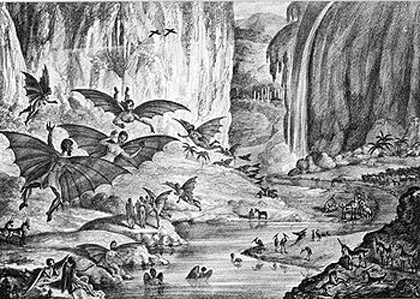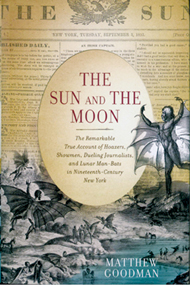In the late summer of 1835, the fledgling New York newspaper The Sun published the remarkable and “true” account of recent discoveries made upon the moon. Using a newly developed telescope, Sir John Herschel (Royal Astronomer) was able to observe unicorns, bison, birds, and a civilization of winged humanoids. He dubbed these humanoids Vespertilio-homo, the man-bat, and over six installments The Sun described their world.
Matthew Goodman’s The Sun and The Moon: the Remarkable True Account of Hoaxers, Showmen, Dueling Journalists, and Lunar Man-Bats in Nineteenth-Century New York recounts those weeks when the city was infatuated with the Great Moon Hoax. The book brings together such disparate characters as Sir John Herschel, P.T. Barnum, and Edgar Allan Poe among others. Most entertaining of all, Goodman paints a vivid picture of the city at a time when editors fought not just in print but also in the streets. (Some similarities to the blogosphere can be found.)

The Sun was the first penny paper in the city. Its publishers prided themselves on being the “public’s” newspaper (as opposed to the majority of other papers that catered solely to the wealthy and merchant classes). On account of the hoax, The Sun‘s circulation soon rose to surpass the distribution of all of New York’s other newspapers combined. Scholars and leading citizens debated whether or not Herschel’s reported claims might be true. Most everyone believed in its veracity, and charities were formed with the express purpose of sending the man-bats bibles. Sir John Herschel himself heard of it eventually and the astronomer was amazed at the claims being made in his name.
The story’s actual author, Richard Adams Locke, had a reputation for being the best-educated journalist in New York. He was an abolitionist and an atheist, when being either put one’s life and property at risk. His intentions for writing the articles were probably multiple. He may have wanted to escape from reality with its pro-slavery rallies and imagine a better place than this world. Or, his articles may be seen as satire, poking fun at the theistic ideas that clouded the sciences, as he claimed decades after the hoax’s publication. For years astronomers had described the moon’s environs, depicting a world of forests, mountains, misty glades, and temples. Some scientists had already suggested that symbols be burned into the Siberian plateau in order to communicate with our lunar neighbors. Locke took these accounts and with rigorous attention to detail began to construct his own version of lunar life. Even after the hoax was revealed, Locke maintained the respect of the populace simply because he had done such a good job crafting his tale.
Throughout the book, Goodman allows his narrative to take sidetracks, providing a rich backdrop for his own account. That the city was hungry for spectacle and eager to believe a number of outlandish claims becomes apparent in the story of Joice Heth. Heth was an elderly African-American woman who P.T. Barnum exhibited as George Washington’s former nursemaid. That this would have made the woman over 150 years of age only increased her appeal as an attraction. The world of newspapers is presented in all its fractious and contentious glory, from Benjamin Day, The Sun’s publisher, and Richard Adams Locke, down to James Gordon Bennett, the publisher of The Herald and the hoax’s most virulent detractor.
While the book may retread the same ground two or three times, The Sun and The Moon succeeds in captivating the reader and recreating a lost era. Whether or not the Great Moon Hoax counts as science fiction might be another matter.










